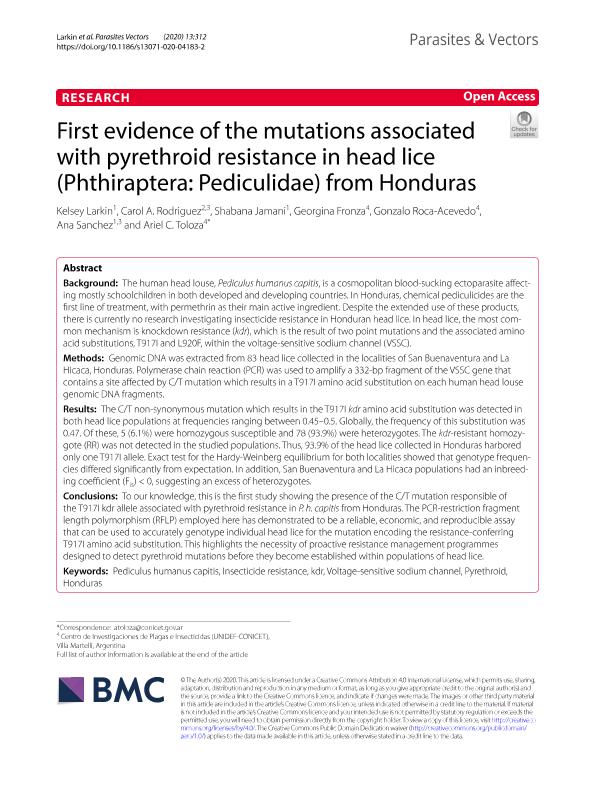Artículo
First evidence of the mutations associated with pyrethroid resistance in head lice (Phthiraptera: Pediculidae) from Honduras
Larkin, Kelsey; Rodriguez, Carol A.; Jamani, Shabana; Fronza, Georgina ; Roca Acevedo, Gonzalo
; Roca Acevedo, Gonzalo ; Sanchez, Ana; Toloza, Ariel Ceferino
; Sanchez, Ana; Toloza, Ariel Ceferino
 ; Roca Acevedo, Gonzalo
; Roca Acevedo, Gonzalo ; Sanchez, Ana; Toloza, Ariel Ceferino
; Sanchez, Ana; Toloza, Ariel Ceferino
Fecha de publicación:
06/2020
Editorial:
BioMed Central
Revista:
Parasites and Vectors
ISSN:
1756-3305
Idioma:
Inglés
Tipo de recurso:
Artículo publicado
Clasificación temática:
Resumen
Background: The human head louse, Pediculus humanus capitis, is a cosmopolitan blood-sucking ectoparasite afect‑ ing mostly schoolchildren in both developed and developing countries. In Honduras, chemical pediculicides are the frst line of treatment, with permethrin as their main active ingredient. Despite the extended use of these products, there is currently no research investigating insecticide resistance in Honduran head lice. In head lice, the most com‑ mon mechanism is knockdown resistance (kdr), which is the result of two point mutations and the associated amino acid substitutions, T917I and L920F, within the voltage-sensitive sodium channel (VSSC). Methods: Genomic DNA was extracted from 83 head lice collected in the localities of San Buenaventura and La Hicaca, Honduras. Polymerase chain reaction (PCR) was used to amplify a 332-bp fragment of the VSSC gene that contains a site afected by C/T mutation which results in a T917I amino acid substitution on each human head louse genomic DNA fragments. Results: The C/T non-synonymous mutation which results in the T917I kdr amino acid substitution was detected in both head lice populations at frequencies ranging between 0.45–0.5. Globally, the frequency of this substitution was 0.47. Of these, 5 (6.1%) were homozygous susceptible and 78 (93.9%) were heterozygotes. The kdr-resistant homozy‑ gote (RR) was not detected in the studied populations. Thus, 93.9% of the head lice collected in Honduras harbored only one T917I allele. Exact test for the Hardy-Weinberg equilibrium for both localities showed that genotype frequen‑ cies difered signifcantly from expectation. In addition, San Buenaventura and La Hicaca populations had an inbreed‑ ing coefcient (Fis) < 0, suggesting an excess of heterozygotes. Conclusions: To our knowledge, this is the frst study showing the presence of the C/T mutation responsible of the T917I kdr allele associated with pyrethroid resistance in P. h. capitis from Honduras. The PCR-restriction fragment length polymorphism (RFLP) employed here has demonstrated to be a reliable, economic, and reproducible assay that can be used to accurately genotype individual head lice for the mutation encoding the resistance-conferring T917I amino acid substitution. This highlights the necessity of proactive resistance management programmes designed to detect pyrethroid mutations before they become established within populations of head lice.
Archivos asociados
Licencia
Identificadores
Colecciones
Articulos (IIIA)
Articulos de INSTITUTO DE INVESTIGACION E INGENIERIA AMBIENTAL
Articulos de INSTITUTO DE INVESTIGACION E INGENIERIA AMBIENTAL
Articulos(UNIDEF)
Articulos de UNIDAD DE INVESTIGACION Y DESARROLLO ESTRATEGICOS PARA LA DEFENSA
Articulos de UNIDAD DE INVESTIGACION Y DESARROLLO ESTRATEGICOS PARA LA DEFENSA
Citación
Larkin, Kelsey; Rodriguez, Carol A.; Jamani, Shabana; Fronza, Georgina; Roca Acevedo, Gonzalo; et al.; First evidence of the mutations associated with pyrethroid resistance in head lice (Phthiraptera: Pediculidae) from Honduras; BioMed Central; Parasites and Vectors; 13; 1; 6-2020; 1-7
Compartir
Altmétricas



